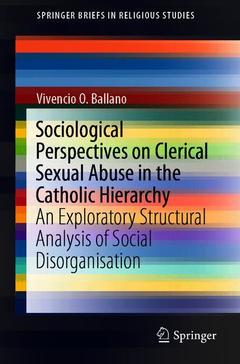Description
Sociological Perspectives on Clerical Sexual Abuse in the Catholic Hierarchy, 1st ed. 2019
An Exploratory Structural Analysis of Social Disorganisation
SpringerBriefs in Religious Studies Series
Author: O. Ballano Vivencio
Language: English
Subjects for Sociological Perspectives on Clerical Sexual Abuse in...:
Keywords
Catholic Clerical Sexual Abuse; Social Disorganization; Catholic Hierachy; Social networks in the Catholic Church; Clerical celibacy; Clerical Abuse in the Catholic Hierarchy; Sexual Scandals in the Catholic Church; Lay empowerment; Social Interaction of the Clergy; Supervision of Clerical Behavior in the Hierarchy; Social Disorganization Theory; Social control; Catholic Laity; Social Bonding in the Clerical Community
Approximative price 58.01 €
In Print (Delivery period: 15 days).
Add to cart97 p. · 15.5x23.5 cm · Paperback
Description
/li>Contents
/li>Biography
/li>Comment
/li>
This book, as an exploratory sociological analysis, broadly examines the major structural factors which contribute to the social disorganization of the Catholic hierarchy as a clerical community, facilitating the persistence of clerical sexual abuse in the Catholic Church. Using some tenets of the social disorganization theory on crime and deviance as the overall theoretical framework with some perspectives from social organization, social network, and social capital, and secondary literature and qualitative data to support the arguments, it examines the (1) diocesan clergy?s social interaction, mutual support, and social control system in the hierarchical community, (2) connection between mandated clerical celibacy and clerical sexual abuse, and (3) the implication of the laity?s lack of empowerment and ecclesiastical authority to monitor and sanction clerical behavior. The Catholic hierarchy prides itself as a unified community of clerics under the Pope who shares the one priesthood of Christ. But the current clerical sexual scandals and the inability of bishops to adequately manage clerical sexual abuse cases make one wonders whether the Catholic clergy is indeed a cohesive and socially organized community which inhibits clerical sexual abuse. This book invites Church authorities, theologians, scholars, and lay leaders to understand the persistent clerical sexual abuse empirically and to come up with structural reforms which enhance the social network and social control systems of the Catholic hierarchy against clerical sexual misconduct and support victims.
Takes a novel, exclusively sociological approach in analyzing the structural roots of clerical sexual abuse in the Catholic hierarchy as a clerical community
Applies a social disorganization perspective to the current clerical sexual abuses in the Catholic Church
Analyzes the disorganizing effects of mandatory clerical celibacy and weak lay participation to the Catholic hierarchy




